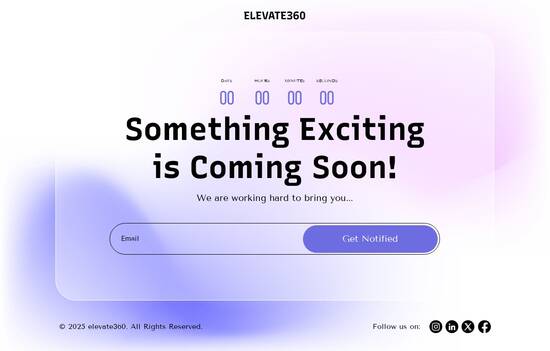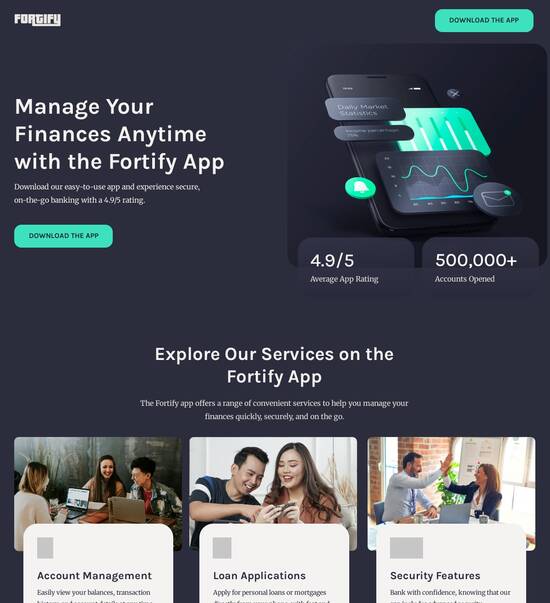
Storytelling terms and conditions page template
Explore Similar TemplatesAbout template
Unleash your creativity with the storytelling terms and conditions page template. Try Instapage today.
Recommended templates

Easy to build without coding
With the intuitive drag-and-drop builder, anyone on your team can create high-converting pages without any knowledge of code or design. Make enhancements to your landing page with custom widgets using Javascript, HTML/CSS, or third-party scripts.

Multiple layouts for any industry and goal
Select from 500+ landing page layouts built to boost conversions across industry-specific scenarios. Customize them by adjusting fonts, adding images, and generating on-brand content with the AI assistant. Quickly scale with Instablocks® and Global Blocks that you can save, reuse, and update globally.

Loads fast and looks polished on any device
Every template is responsive, which means they present professionally on any device and load blazingly fast with our Thor Render Engine. You can also power them up with Google AMP technology to deliver an unparalleled mobile experience and drive higher conversions.

Robust analytics & experimentation
Get real-time updates and reporting across all your devices, showing the number of visitors, conversions, cost-per-visitor, and cost-per-lead. Launch AI-powered experiments, run A/B tests, and use heatmaps to analyze user behavior, then optimize your landing page to maximize conversions.







Easy to build without coding
With the intuitive drag-and-drop builder, anyone on your team can create high-converting pages without any knowledge of code or design. Make enhancements to your landing page with custom widgets using Javascript, HTML/CSS, or third-party scripts.
Multiple layouts for any industry and goal
Select from 500+ landing page layouts built to boost conversions across industry-specific scenarios. Customize them by adjusting fonts, adding images, and generating on-brand content with the AI assistant. Quickly scale with Instablocks® and Global Blocks that you can save, reuse, and update globally.
Loads fast and looks polished on any device
Every template is responsive, which means they present professionally on any device and load blazingly fast with our Thor Render Engine.
Robust analytics & experimentation
Get real-time updates and reporting across all your devices, showing the number of visitors, conversions, cost-per-visitor, and cost-per-lead. Launch AI-powered experiments, run A/B tests, and use heatmaps to analyze user behavior, then optimize your landing page to maximize conversions.
All the features you need to build lead-generating landing pages
Explore more featuresLearn how to build top-performing landing pages for any goal
FAQs
Leading the way in building high-performing landing pages





A comprehensive step-by-step guide to utilizing Instapage for high-converting landing pages
Instapage is the most powerful platform for creating landing pages and optimizing conversion rates. This guide will walk you through the essentials of using Instapage to enhance your digital marketing campaigns, achieving maximum ROI and effective lead generation.
Step 1: Access Ready-to-Use Templates
Begin your journey by exploring Instapage’s library that features over 100 high-converting templates. These templates are designed specifically for various industries, ensuring relevance and effectiveness in your campaigns.
- Diverse templates tailored for different marketing goals and industries.
- Pre-built lead generation elements like forms and CTAs that are easy to customize.
- Intuitive builders enabling fast page creation without coding knowledge.
Step 2: Build Your Landing Page Efficiently
Once you've selected your template, customizing it to fit your brand and message is crucial. Instapage allows you to leverage the flexibility of drag-and-drop functionality to accelerate page development.
- Use Instablocks to reuse design elements across multiple pages for consistency.
- Ensure your landing page layout directs visitors towards key actions like signing up or making a purchase.
- Integrate multimedia elements effectively to engage your audience directly.
Step 3: Optimize for Higher Conversions
Optimization is vital for enhancing conversion rates. Utilize Instapage’s built-in experimentation tools such as A/B testing and heatmaps to understand visitor behaviors.
- Conduct A/B tests to compare different versions of your landing pages and identify which elements perform best.
- Analyze heatmaps to see where users are clicking, which can inform design improvements.
- Regularly assess the performance through the analytics dashboard to make data-driven decisions.
As you develop your marketing strategy, remember that continuous optimization is key to sustained success.
Conclusion: By harnessing the powerful tools offered by Instapage, marketers can create and optimize landing pages that yield exceptional results.
Ready to elevate your marketing campaigns with Instapage? Start your free trial today and unlock the potential of high-converting landing pages.
People also ask about Storytelling terms and conditions page template
Understanding the storytelling terms and conditions page template: A deep dive
The importance of terms and conditions pages
Terms and conditions pages serve as a vital legal framework for businesses and their users. They outline the rules and guidelines that govern the use of a website or service, providing clarity on the expectations from both parties involved. Not only do these pages protect a company's interests by laying out legal rights, responsibilities, and liabilities, but they also serve as a reference for customers should disputes arise.
The legal significance of a terms and conditions page becomes apparent when considering the potential ramifications of not having one. Without this essential document, businesses might face legal challenges or significant liability issues. On the user's end, unclear or nonexistent terms can lead to misunderstandings or exploitation, highlighting the necessity of well-articulated policies.
The role of storytelling in engaging users
Storytelling transforms the often dry legal language of terms and conditions into an engaging narrative that users can relate to. Instead of presenting users with a wall of jargon, employing storytelling techniques can craft a context that encapsulates real-life scenarios and resonates with their experiences. This approach not only makes the content more approachable but enhances user retention and understanding.
By integrating narrative elements, companies can demystify complex legal principles. This storytelling technique humanizes the text, encouraging users to see terms and conditions as beneficial guidelines rather than obstacles. Overall, weaving narratives into these legal frameworks fosters transparency and builds trust between businesses and consumers.
Key components of an effective terms and conditions page template
An effective terms and conditions page should contain several core elements that make it comprehensive and user-friendly. Fundamental sections to include are user responsibilities, liabilities, rights, and a clear explanation of the terms of service. Each section helps clarify duties, entitlements, and liabilities, enabling users to understand their standing in relation to the service.
A well-structured template breaks down risk management as well, addressing potential pitfalls for both users and businesses. It's important to clearly articulate the risks and how both parties can manage them, enhancing overall transparency.
Tailoring terms to specific services
Customizing terms and conditions according to specific business types is essential for optimal transparency and effectiveness. Different industries have unique requirements and risks that need addressing. For example, a SaaS company might include clauses relating to data privacy and service availability, while a retail business would focus on product return policies.
Industry-specific clauses enhance clarity and are crucial for preventing misunderstandings or legal disputes. This tailoring not only addresses user needs but also positions the company as knowledgeable and trustworthy in its specific field.
The benefits of clarity and transparency
Clarity and transparency in a terms and conditions page reduce misunderstandings, fostering user trust. When users can easily comprehend their rights and obligations, they are more likely to view the company favorably. A clear set of guidelines minimizes the chances of disputes and builds a more engaged customer base.
To achieve such clarity, it's advisable to use straightforward language. Avoiding heavy legal jargon helps ensure that all users, regardless of their background, can effectively grasp the content. This approach not only meets users’ expectations but also encourages a culture of compliance and respectful engagement.
Transformative features of Instapage's terms and conditions generator
Instapage’s terms and conditions generator revolutionizes the process of creating these essential pages. By simplifying the drafting phase, businesses can start focusing on providing value rather than getting bogged down in legal minutia. The generator walks users through a step-by-step process, making it easy to include relevant sections and customize content as needed.
One of the standout features is the integration of interactive elements that enhance user engagement. Beyond just text, businesses can incorporate storytelling formats like FAQs, infographics, and case studies, offering users multiple ways to engage with the material. These features promote not only understanding but also retention of critical information.
Responsiveness and adaptability
Another advantage of using Instapage’s terms and conditions generator is its adaptability across various devices and formats. Given that users access information from a multitude of screens, it’s crucial to ensure that terms and conditions are readable and searchable on all formats. By providing customization options, businesses can cater to different user experiences and preferences.
This attention to responsiveness not only aids in comprehension but is instrumental in maintaining professional presentation. Furthermore, ensuring compatibility with various website platforms enhances accessibility, making it easier for users to review and understand their obligations and rights.
Addressing common mistakes in terms and conditions creation
Creating effective terms and conditions is a nuanced process, and businesses frequently make common mistakes. One prevalent error is ignoring essential clauses that are crucial for comprehensive protection. Alternatively, some companies overcomplicate their language, leading to confusion rather than understanding. Both shortcomings can result in significant liability issues that can be costly and damaging.
Moreover, failing to address specific user needs can lead to unexpected challenges. It's essential to consider the unique concerns of the target audience thoroughly. Addressing these risks while keeping the language accessible ensures that users understand their rights and obligations.
The cost of incomplete or vague terms
The implications of creating incomplete or vague terms should not be underestimated. Businesses can face real consequences, ranging from legal disputes to substantial financial losses. For instance, unclear limitations on liability might lead to lawsuits that could have been easily avoided with proper wording.
Clarity and thoroughness in terms and conditions play a pivotal role in mitigating such risks. By establishing clear, well-defined rules, businesses can navigate potential challenges with confidence and reduce the likelihood of customer dissatisfaction.
Proactive measures for improvement
To maintain the effectiveness of terms and conditions, regular updates and revisions should be made a priority. These adjustments ensure that content stays relevant as laws and business practices evolve. User feedback can also serve as a valuable resource for refining and improving the terms, as it provides insights into user experiences and expectations.
Encouraging users to provide feedback not only demonstrates a commitment to transparency but also helps businesses stay aligned with their audience’s needs and preferences.
Strategies for enhancing user engagement with terms and conditions
Employing storytelling techniques can play a significant role in crafting terms and conditions that resonate with users. By creating a narrative that addresses common user concerns, businesses can facilitate a deeper connection to the content. For instance, case studies that illustrate policies in action can help users visualize scenarios where these terms apply.
Additionally, a user-friendly layout enhances engagement. Incorporating visual elements such as icons, bullet points, and infographics can break up dense text, making it more approachable and digestible. Use of clear headings and strategic spacing can guide users through the content, allowing them to easily locate the information they need.
Feedback mechanisms for user input
Integrating feedback mechanisms into the terms and conditions page encourages user participation and input. This could be as simple as a feedback form or a survey, allowing users to express their concerns or suggestions about the terms. Not only does this promote user-centricity, but it also provides businesses with insights on how their policies are perceived.
Customer insights can guide the ongoing refinement of the content, ensuring that it remains clear, relevant, and easy to navigate. Engaging users in this way fosters a community where dialogue is encouraged, taking the relationship beyond transactional to build longer-lasting trust.
The risks of neglecting terms and conditions
Ignoring the importance of terms and conditions can yield serious legal consequences. Businesses may face litigation or regulatory penalties if they fail to establish a clear legal framework governing the use of their services. Real scenarios illustrate that without adequate agreements, businesses have faced lawsuits that have not only drained finances but also damaged reputations significantly.
The potential fallout does not merely rest on legal implications. A lack of clear terms can lead to customer dissatisfaction, impacting trust and loyalty towards a brand. Recovering from such disputes requires comprehensive damage control strategies that can further strain resources and undermine business credibility.
The impact on business reputation
Maintaining user trust is foundational to building a reputable brand. Businesses that neglect their terms and conditions risk their users perceiving them as untrustworthy or unprofessional. This perception can be long-lasting, and overcoming reputational damage often demands extensive efforts and time.
To preserve and enhance brand loyalty, businesses need to proactively manage disputes. This involves transparent communication, timely responsiveness, and a commitment to addressing user concerns. Establishing solid terms and conditions helps in creating a defendable position when issues arise.
Future-proofing your website legalities
In an ever-shifting legal landscape, business owners must anticipate changes in regulations and update their terms and conditions accordingly. By regularly reviewing and refining these legal documents, businesses can address foreseeable challenges and demonstrate compliance with industry standards.
Moreover, staying informed about industry trends and legal updates allows companies to proactively adapt their strategies, ensuring that they're not only compliant but also responsible in their business practices.
Practical examples and templates
Having access to sample terms and conditions can significantly aid businesses in the creation of their own. A walkthrough of a sample template and its components reveals the essential features that make a terms page effective. For instance, providing clear definitions upfront, concise user obligations, and explicit disclaimers are integral to clarity.
When customizing templates, businesses ought to consider key aspects such as their audience's demographics. Adjusting language and examples used in their terms to align with the user's knowledge and experience can greatly enhance understanding and compliance.
Encouraging compliance through clear guidelines
Clear guidelines are crucial in ensuring that users understand their rights and obligations comprehensively. It's essential to communicate these in a manner that is engaging yet informative. By breaking down complex terms into straightforward bullet points or graphics, users are more likely to follow along without feeling overwhelmed.
Furthermore, fostering a culture of compliance requires continuous communication. Regular updates through newsletters or site notifications about any changes in terms can enhance users' awareness and encourage ongoing engagement with the terms and conditions.
Resources for ongoing improvement
To improve the terms and conditions page continually, businesses can evaluate user feedback systematically. Gathering insights through polls, direct feedback on the content, or usability studies helps pinpoint areas for enhancement. This iterative process allows companies to stay responsive to user needs.
Staying abreast of legal considerations is equally crucial. Committing to best practices and regularly consulting legal professionals or industry experts can ensure that terms and conditions remain relevant and compliant with changing laws. Integrating these insights into the terms not only promotes clarity and engagement but also reinforces a sense of accountability toward users.
Conclusion on the significance of storytelling in terms and conditions
In conclusion, effective terms and conditions are not merely legal obligations; they are vehicles for clearer communication and trust. By revisiting the balance between stringing together legal stipulations and narrating user experiences, businesses can forge stronger connections with their users.
The role of innovative templates and generators is shaping the future of legal transparency. Encouraging a user-centric approach fosters an environment where fair practices and clear guidelines thrive, influencing a shift towards more responsible business strategies.
Ready to skyrocket conversions?
Supercharge your ad campaigns with high-performing landing pages
Get started














